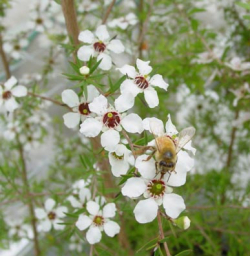 Leptospermum scoparium (Manuka or Tea tree)
Leptospermum scoparium (Manuka or Tea tree)
Leptospermum is a shrub or small tree native to New Zealand and southeast Australia. It is found throughout New Zealand but is particularly common on the drier east coasts of the North Island and the South Island, and in Australia in Tasmania, Victoria and New South Wales.
Manuka (from Māori 'mānuka') is the common name used in New Zealand, whereas 'tea tree' is a commonly used in Australia. This name arose because Captain Cook (who was one of the first explorers to come to NZ) used the leaves to make a 'tea' drink. The common name "Tea Tree" is also shared with the related Melaleuca tree of Australia suggesting that both were used to make tea by Captain Cook.
As well as a range of seeded wild types there are various ornamental varieties that are regularly sold in garden centres and some used for cutflower-foliage production. Manuka can be shaped and hedged so lends itself well to landscaping and general garden use
Growth
Manuka is a prolific scrub-type tree and is often one of the first species to regenerate on cleared land. In the past many New Zealand farmers have spent considerable time and money to clear it in favour of grass pastures.
It is typically a shrub growing to 2–5 m tall, but can grow into a moderately sized tree, up to 15 m or so in height. It is evergreen, with dense branching and small leaves 7–20 mm long and 2–6 mm broad, with a short spine tip. The flowers are white, occasionally pink, 8–15 mm (rarely up to 25 mm) diameter, with five petals.
This species is often confused with the closely related species Kānuka ( Kunzia) - the easiest way to tell the difference between the two species in the field is to feel their foliage - Manuka leaves are prickly while Kanuka leaves are soft and smaller.The wood is tough and hard, and was often used for tool handles. Manuka sawdust imparts a delicious flavour when used for smoking meats and fish.
Medical and health benefits
Manuka products have high antibacterial potency for a limited spectrum of bacteria and are widely available in New Zealand. Similar properties led the Māori to use parts of the plant as natural medicine.
Kakariki parakeets (Cyanoramphus) use the leaves and bark of Manuka and Kanuka to rid themselves of parasites. Apart from ingesting the material, they also chew it, mix it with preen gland oil and apply it to their feathers.
Manuka honey, produced when honeybees gather the nectar from its flowers, is distinctively flavoured, darker and richer in taste than clover honey and has strong antibacterial and antifungal properties.The finest quality Manuka honey with the most potent antimicrobial properties is produced from hives placed in wild, uncultivated areas with abundant growth of Manuka bushes. Various scientific studies have been performed to verify its efficacy.
The Active Manuka Honey Association (AMHA) is the industry association that promotes and standardizes the production of Manuka honey for medical uses. They have created the Unique Manuka Factor (UMF) standard which grades honey based on its anti-bacterial strength. Because of its antimicrobial properties, Manuka Honey is added in small amounts D-Dartos Oral Suspension and other products. In January 2008 Professor Thomas Henle, University of Dresden (Germany) identified methylglyoxal as the active compound in Manuka honey. This is now shown on products as MGO Manuka honey. E.g. MGO 100 represents 100 mg of methylglyoxal per kilogram.

